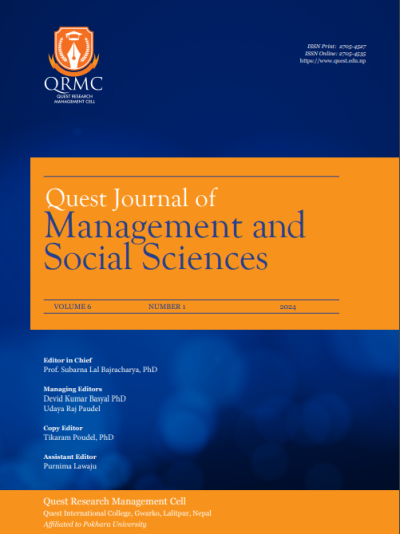The South China Sea Dispute and Regional Response
DOI:
https://doi.org/10.3126/qjmss.v6i1.67377Keywords:
South China Sea Dispute, Regional Response, Territorial Claims, Geopolitical Implications, ASEAN, RealismAbstract
Background: Beginning in December 2013, the South China Sea dispute has emerged as a complex and highly contested issue with significant implications for regional stability in East and Southeast Asia. The Chinese military began constructing artificial islands anchored by seven coral atolls in the Spratly Islands until it had created land that it then claimed in October 2015. The construction is over 3000 acres and houses military equipment (anti-aircraft and anti-missile systems) and personnel for the People's Republic of China.
Objective: From a realist perspective, the dispute reflects a struggle for power and influence among claimant states, driven by their desire to secure regional strategic interests. Neighbouring countries, recognising the implications of China's rise as a significant power, have responded mainly by using soft realist methods to accommodate or counter China's growing influence in a collective setting. This paper explores the geopolitical implications of the dispute and how other powers have chosen to engage with China and other regional actors.
Methods: This article is a case study. The article analyses the case of the South China Sea dispute since 2000 through a realist lens. It first explains the lens and its focal points. Then, it examines the different facets of the dispute through this lens: economic interests, national security concerns, domestic and regional politics, and historical issues. The focus is on analysing China and ASEAN member-states as the primary parties to the conflict.
Results: This lens provides valuable insights into the power struggles, self-interest, and security concerns that underlie the conflict. This paper provides a comprehensive understanding of its multifaceted nature by critically examining the dispute's territorial claims, legal frameworks, and historical context. It also explores the geopolitical implications and the involvement of major regional powers. Liberal solutions have largely failed, while more minor actors have cooperated on limited terms when their interests intersect using soft realist diplomacy and collective action within international arenas.
Conclusion: The dispute has unveiled the limits of international diplomatic efforts brokered by organisations such as ASEAN to address aggressive behaviour consistently. Small and medium states are largely constrained from directly confronting China, have accommodated China, used international forums to advance power positions and prestige, and cooperated on other issues to indirectly address the dispute.
Downloads
Downloads
Published
How to Cite
Issue
Section
License
Copyright (c) 2024 Quest Journal of Management and Social Sciences

This work is licensed under a Creative Commons Attribution-NonCommercial-NoDerivatives 4.0 International License.
This license enables reusers to copy and distribute the material in any medium or format in unadapted form only, for noncommercial purposes only, and only so long as attribution is given to the creator.




